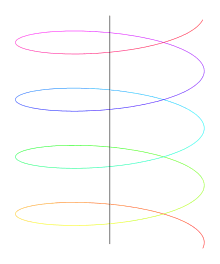Chasles' theorem (kinematics)

In kinematics, Chasles' theorem or Mozzi-Chasles' theorem says that the most general rigid body displacement can be produced by a translation along a line (called its screw axis or Mozzi axis) followed (or preceded) by a rotation about that line.[1][2]
History
The proof that a spatial displacement can be decomposed into a rotation and slide around and along a line is attributed to the astronomer and mathematician Giulio Mozzi (1763), in fact the screw axis is traditionally called asse di Mozzi in Italy. However, most textbooks refer to a subsequent similar work by Michel Chasles dating 1830.[3] Several other scholars contemporaries of M. Chasles obtained the same or similar results around that time, including G. Giorgini, Cauchy, Poinsot, Poisson and Rodrigues. An account of the 1763 proof by Giulio Mozzi and some of its history can be found here.[4][5]
Proof
Mozzi considers a rigid body undergoing first a rotation about an axis passing through the center of mass and then a translation of displacement D in an arbitrary direction. Any rigid motion can be accomplished in this way due to a theorem by Euler on the existence of an axis of rotation. The displacement D of the center of mass can be decomposed into components parallel and perpendicular to the axis. The perpendicular (and parallel) component acts on all points of the rigid body but Mozzi shows that for some points the previous rotation acted exactly with an opposite displacement, so those points are translated parallelly to the axis of rotation. These points lie on the Mozzi axis through which the rigid motion can be accomplished through a screw motion.
Another elementary proof of Mozzi-Chasles' theorem was given by E. T. Whittaker in 1904.[6] Suppose A is to be transformed into B. Whittaker suggests that line AK be selected parallel to the axis of the given rotation, with K the foot of a perpendicular from B. The appropriate screw displacement is about an axis parallel to AK such that K is moved to B. The method corresponds to Euclidean plane isometry where a composition of rotation and translation can be replaced by rotation about an appropriate center. In Whittaker's terms, "A rotation about any axis is equivalent to a rotation through the same angle about any axis parallel to it, together with a simple translation in a direction perpendicular to the axis."
References
- ↑ Kumar, V. "MEAM 520 notes: The theorems of Euler and Chasles" (PDF). University of Pennsylvania. Retrieved 6 August 2014.
- ↑ Heard, William B. (2006). Rigid Body Mechanics. Wiley. p. 42. ISBN 3-527-40620-4.
- ↑ Chasles, M. (1830). "Note sur les propriétés générales du système de deux corps semblables entr'eux". Bulletin des Sciences Mathématiques, Astronomiques, Physiques et Chemiques (in French). 14: 321–326.
- ↑ Mozzi, Giulio (1763). Discorso matematico sopra il rotamento momentaneo dei corpi (in Italian). Napoli: Stamperia di Donato Campo.
- ↑ Ceccarelli, Marco (2000). "Screw axis defined by Giulio Mozzi in 1763 and early studies on helicoidal motion". Mechanism and Machine Theory. 35: 761–770.
- ↑ E. T. Whittaker (1904) A Treatise on Analytical Dynamics of Particles and Rigid Bodies, p. 4, at Google Books
Further reading
- Benjamin Peirce (1872) A System of Analytical Mechanics, III. Combined Motions of Rotation and Translation, especially § 32 and § 39, David van Nostrand & Company, link from Internet Archive
